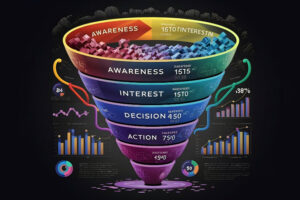- info@uxgenmarketing.com
- U-211, Vaishnav Enclave, Sec 67A. Gurugram. Haryana. 122101
Data-Driven Copywriting: Turning Analytics into Words That Sell

Data-Driven Copywriting: Turning Analytics into Words That Sell
Your copy is performing — even when you think it isn’t.
That above-the-fold headline that sounded great in meetings? If it’s paired with a 78% bounce rate, it’s not working. That clever CTA button design? If no one is clicking it, it’s decorative — not directional.
In a saturated digital landscape, data-driven copywriting isn’t just a trend — it’s a necessity. At UXGen Marketing, we craft messaging that balances creative spark with behavioral logic — using tools like scroll maps, A/B tests, and performance metrics to connect message with metric.
We don’t just write for creativity. We write to convert — consistently.
What Is Data-Driven Copywriting?
Data-driven copywriting is not about stripping emotion or tone from your brand voice. It’s about writing with informed intent, based on how users actually behave on your website, app, or campaign journey.
Instead of asking “what sounds good?” we ask “what works — and why?”
At UXGen Marketing, our writing teams work closely with analysts and product marketers to interpret:
-
Behavior analytics like click maps, session replays, and form drop-offs
-
A/B testing results for headlines, email subject lines, and landing pages
-
Voice-of-customer data from support tickets, live chat, or reviews
-
Ad and email performance metrics across paid platforms
The result? Messaging that meets the user where they are, in language they recognize — not just what we want to say.
See how UXGen Marketing blends data, behavior, and messaging to create content that converts.
Case in Point: When Words Miss the Mark
We worked with a client whose landing page was visually stunning — yet had a bounce rate over 70%. After reviewing heatmaps and user recordings, it was clear users were scrolling past the hero section without engaging.
Why? The copy led with features, not value.
We rewrote the header to focus on the end benefit: how much time the product saved users weekly. We followed it up with one testimonial line, and moved the CTA higher. The change reduced bounce by 32% and improved conversions by 17% in just one week.
Design didn’t change. Words did.
Our Process: Turning Data into Copy That Converts
Here’s the structured approach we use at UXGen Marketing to transform data into revenue-driving content.
1. Map Behavior
We track how users interact with a page using tools like Hotjar, GA4, or Microsoft Clarity. Scroll maps, click paths, and exit rates help identify where attention drops.
2. Spot Friction
We look for common friction points — too much copy, unclear CTAs, or copy that doesn’t align with ad messaging. Every disconnect is a lost opportunity.
3. Listen to Your Customer
We extract insights from support conversations, feedback forms, and even social comments to find real words your audience uses. This often uncovers phrasing that performs better than industry lingo.
4. Reframe and Reposition
We rewrite key sections — headlines, CTAs, bullets — to reflect user priorities. We clarify value, sharpen benefits, and reduce unnecessary filler.
5. Test and Repeat
We push the new copy live in split tests, monitoring scroll behavior, click-through rates, bounce, and conversions. Then we iterate again.
Copywriting, when done right, isn’t about getting it perfect. It’s about getting it tested.
Let UXGen Marketing turn bounce rates and scroll maps into high-converting campaigns.
How UXGen Ventures Align for Smarter Messaging
At UXGen Design Studio, UX audits often reveal where design and messaging misalign. For example, a form that visually works but confuses users due to unclear prompts. Their findings help us refine copy not just for tone — but for clarity.
UXGen Technologies provides dashboards that bring enterprise-level behavioral insights into the conversation. This gives us structured performance data across journeys — helpful when refining messaging across multi-step flows.
At UXGen Academy, students in the performance marketing and UX writing modules are now taught to blend data interpretation with storytelling. It’s no longer about guessing what words might work — it’s about understanding the behavioral why.
Together, these cross-venture insights shape a more mature, consistent approach to messaging across the full user lifecycle.
Copy Pitfalls We Help Brands Avoid
When auditing campaigns or landing pages, these common issues surface time and again:
-
Leading with product specs instead of solving a user problem
-
Using internal or brand-centric jargon instead of relatable language
-
Overstuffed messaging — trying to say too much, too early
-
Ignoring CTA clarity or failing to create urgency
-
Writing long-form copy without checking scroll or attention depth
Pretty doesn’t mean persuasive. And clever doesn’t mean clear. What matters is performance.
Why It’s Time to Write Differently
As AI tools flood the internet with more content than ever before, users are tuning out anything generic.
They want clarity. They want empathy. And they want messaging that reflects that a real human understands their goals — even before they click.
Data gives us the lens to deliver that. It shows what users care about, how they move, and what holds them back from converting. When your copy speaks directly to those patterns, conversion becomes a natural next step — not a push.
Conclusion
Words can do a lot — inspire, inform, influence. But in digital marketing, they also need to perform. Not once. Not by luck. But consistently, across devices, platforms, and attention spans.
Data-driven copywriting isn’t about removing creativity. It’s about anchoring it in reality. It’s how we write at UXGen Marketing — not for awards or applause, but for results.
Because in the end, good copy doesn’t just speak. It sells.
Explore how UXGen Marketing makes every word count using real-time behavior data.
Frequently Asked Questions
1.What is data-driven copywriting?
It’s a method of writing content — like ads, emails, landing pages, or microcopy — that’s guided by real user behavior, analytics, and testing, rather than intuition alone.
2.Do I need expensive tools to use this approach?
Not necessarily. Free tools like Google Analytics, Hotjar, and Microsoft Clarity offer valuable data that can guide meaningful copy improvements.
3.Is this process useful for small businesses or only large enterprises?
It works for all levels. In fact, startups benefit even more — they can avoid costly messaging missteps early on by writing based on user behavior from day one.
4.Does this only apply to landing pages?
No. You can apply data-driven messaging to ads, email sequences, social media content, onboarding flows — anywhere users are reading and making decisions.
5.Will this make my copy sound robotic or overly analytical?
Not at all. The goal isn’t to write like a machine — it’s to write what matters. In fact, this process often makes copy more human, because it reflects real customer needs and language.








